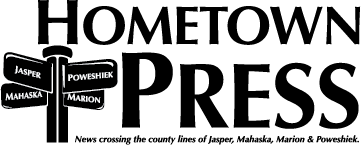Phil Ebert explains the assembly line process for bottling honey to Iowa’s Secretary of Agriculture, Mike Naig, during his 99-county tour on Jan. 28.
As part of his 99-county tour, Iowa Secretary of Agriculture Mike Naig took an opportunity to tour Ebert Honey near Lynnville and speak to Phil Ebert about his family’s operation on Friday, Jan. 28.
What began as a backyard operation of 10 colonies, Phil Ebert and his sons, Alex and Adam, have expanded their operation to over 1,800 hives spread over five counties. Their successes caught the attention of Secretary Naig, who was curious about how the state can help honey producers like Ebert meet the growing demand from consumers, as well as how the whole process works.
“It’s not so much about making colonies as it is keeping them alive,” said Ebert. “Breeding bees is a touchy business.”
Ebert noted one can’t always tell by looking at a hive if the bees are healthy, adding there are nutritional issues from the bees’ diet and environment. He also said insecticide from crops is always an issue, as chemicals in the ground affect the plants the bees pollinate with.
Naig echoed Ebert’s concerns, but is encouraged by the progress he’s seen.
“In the last decade, there have been advances in seed treatment, including the coating, and we hope it continues to improve,” said Naig.
Earlier in the day, Naig toured Brownells in Grinnell as his Poweshiek County stop, and he hit on the connections between the two industries.
“There’s a nexus between hunting, recreation, habitat, and agriculture. It is all interconnected, and when you start talking about how each affects each other, that’s where you start to have the magic,” said Naig. “Diversity is the key to stability.”
For instance, one of the agricultural practices row crop farmers implement is a buffer strip, which is a strip of grass and legume mixture that runs along the contour of a farmed field. Ebert indicated when the right mix of plants and grasses are planted in a buffer strip, it is great for the bees, and it doesn’t take up all the crop ground.
“As honey producers, we don’t need entire fields of pollinating plants, but even corners of fields and road ditches help our hives and honey production thrive,” said Ebert.
Jamie Beyer, a legislative representative for Iowa Honey Producers, was also in attendance and encouraged Naig to use his influence to encourage the Iowa Department of Transportation, as well as county road departments, to continue wildflower seeding in roadside ditches, and not to mow down plants before they’ve gone to seed.
Naig was also interested how the supply chain issues and consumer demand has affected Ebert’s production.
“Our goal is always to produce enough to keep up with demand, but sometimes that doesn’t always work,” said Ebert, as they had to purchase four semi loads, or about 300-400 barrels of honey, to keep up with the rise in honey demand.
Ebert Honey can be found at local grocery and food stores, including area Hy-Vees and Fareways. In addition to honey, Eberts also produce beeswax, selling most of it online.
Naig said his department is looking to start a state-branding initiative called “Choose Iowa,” which would promote locally-grown and made-in-Iowa products.
“I think Ebert Honey would be a natural fit for the program,” said Naig.
Ebert added, “The environment is right for that. It would also help keep food production close to home.”
“If there is a silver lining to the 2020-21 and ongoing pandemic and supply-chain issues, it’s that more people are choosing to shop local, which is great for agriculture in Iowa,” said Naig.



